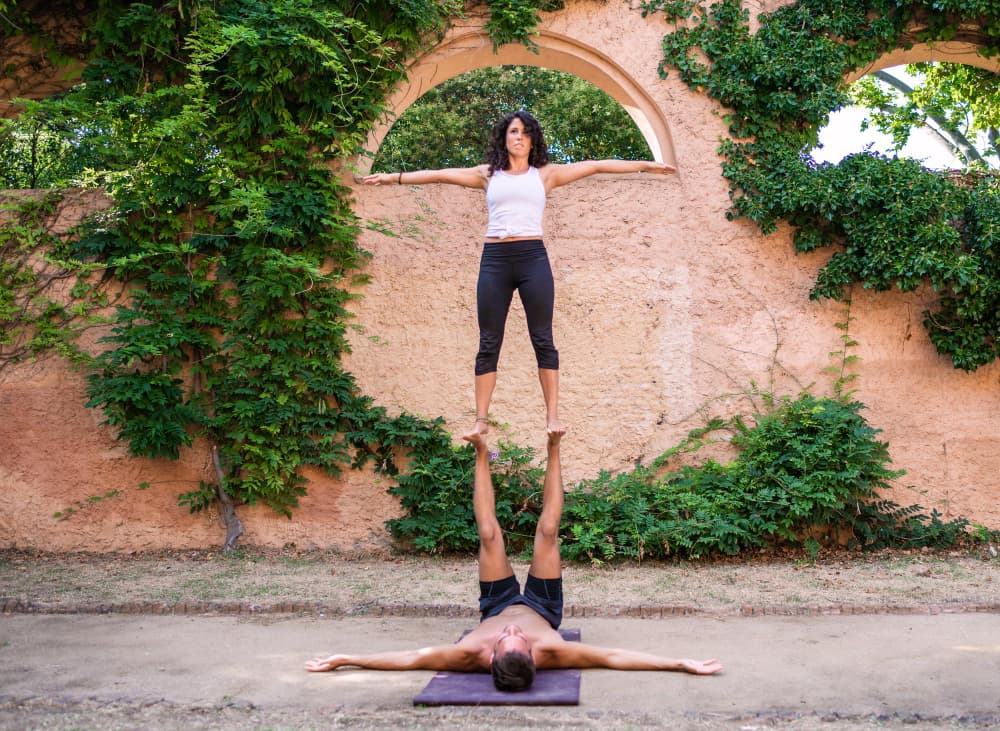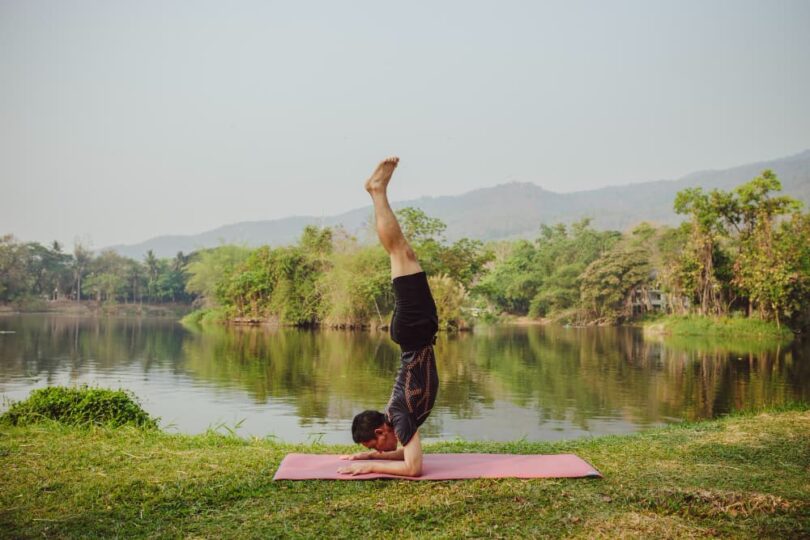Ashtanga Yoga is a dynamic and structured form of yoga that combines breath and movement to create a flowing practice. Originating from ancient Indian traditions, this form of yoga is known for its physically demanding sequences and deep spiritual underpinnings. In this article, we’ll dive into the history, philosophy, practice techniques, and benefits of Ashtanga Yoga. Whether you’re a seasoned yogi or a curious beginner, this guide will provide you with valuable insights into this powerful practice.
Table of Contents
Introduction to Ashtanga Yoga
Ashtanga Yoga, a captivating blend of breath and movement, is a rigorous yet rewarding practice that has captivated yoga enthusiasts worldwide. Rooted in ancient traditions and meticulously structured, Ashtanga Yoga offers a holistic physical and mental well-being approach. In this comprehensive guide, we’ll uncover the layers of this practice, from its historical roots to the benefits it bestows upon its practitioners. Let’s embark on this journey of discovery.
History of Ashtanga Yoga
Ashtanga Yoga boasts a rich history that dates back to the early 20th century. It was popularized by K. Pattabhi Jois, a revered yoga teacher from Mysore, India. Jois’s teachings were based on an ancient manuscript called the “Yoga Korunta,” which he received from his guru, Krishnamacharya. This manuscript outlined a unique yoga practice method that combines breath, movement, and meditation.
Origin and Development
The roots of Ashtanga Yoga can be traced to ancient times, but it gained prominence in the 20th century through the efforts of K. Pattabhi Jois. Jois’s dedication to preserving and sharing this method brought Ashtanga Yoga to the global stage. He established the Ashtanga Yoga Research Institute in Mysore, where students from around the world came to learn and practice.
Key Figures in Ashtanga Yoga
K. Pattabhi Jois is undoubtedly the most influential figure in the history of Ashtanga Yoga. His tireless work in teaching and promoting this practice has left an indelible mark. Additionally, his grandson, Sharath Jois, continues to carry forward the legacy, ensuring that the teachings remain authentic and accessible to future generations.
Evolution Over Time
Over the decades, Ashtanga Yoga has evolved while staying true to its core principles. Modern practitioners have adapted the practice to suit contemporary lifestyles, yet the essence remains unchanged. This balance of tradition and innovation has allowed Ashtanga Yoga to thrive and attract a diverse range of practitioners.
Philosophy of Ashtanga Yoga
The philosophy of Ashtanga Yoga is deeply rooted in the concept of the eight limbs of yoga. These limbs, outlined by the sage Patanjali in the Yoga Sutras, provide a comprehensive framework for living a balanced and meaningful life. The term “Ashtanga” itself means “eight limbs,” signifying the integration of these principles into the practice.
The Eight Limbs of Yoga
- Yama: Ethical principles, such as non-violence and truthfulness.
- Niyama: Personal observances, including cleanliness and contentment.
- Asana: Physical postures that strengthen and purify the body.
- Pranayama: Breath control techniques that enhance life force.
- Pratyahara: Withdrawal of the senses to cultivate inner awareness.
- Dharana: Concentration on a single point or object.
- Dhyana: Meditation or sustained focus.
- Samadhi: A state of transcendence and union with the divine.
Integrating Principles into Practice
The practice of Ashtanga Yoga is designed to incorporate these eight limbs seamlessly. Through the disciplined practice of asanas, pranayama, and meditation, practitioners strive to achieve a state of balance and harmony. This holistic approach ensures that the physical, mental, and spiritual aspects of yoga are all addressed.
Incorporating these ancient principles into a modern practice can be challenging yet immensely rewarding. By adhering to the eight limbs, practitioners can experience profound transformations in their overall well-being.
Related Article: Kundalini Yoga Near Me: Find the Best Classes and Studios
Practice and Techniques in Ashtanga Yoga
Ashtanga Yoga is known for its structured sequences and the seamless flow between poses, creating a dynamic and engaging practice. Let’s dive into the key components that make Ashtanga Yoga unique and effective.
The Primary Series
The Primary Series, also known as Yoga Chikitsa (Yoga Therapy), is the foundation of Ashtanga Yoga practice. It focuses on detoxifying and aligning the body, building strength, and increasing flexibility.
Key Poses and Sequences:
- Surya Namaskar A & B: These sun salutations warm up the body and set the rhythm for the practice.
- Standing Poses: Include poses like Padangusthasana and Utthita Trikonasana, which enhance balance and strength.
- Seated Poses: Involve forward bends and twists like Paschimottanasana and Marichyasana that stretch and detoxify.
- Finishing Sequence: Concludes with inversions and meditative poses such as Savasana for relaxation.
Importance and Benefits: The Primary Series is designed to purify the body and mind. Practitioners often notice improved flexibility, strength, and mental clarity after consistent practice.
The Intermediate and Advanced Series
The Intermediate Series, known as Nadi Shodhana (Nerve Cleansing), and the Advanced Series, called Sthira Bhaga (Divine Stability), take the practice to deeper levels, focusing on more complex poses and advanced techniques.
Intermediate Series:
- Backbends: Deep backbends like Kapotasana open the heart and increase spinal flexibility.
- Hip Openers: Poses such as Eka Pada Sirsasana enhance hip mobility.
Advanced Series:
- Arm Balances: Challenging balances like Handstands build immense strength and focus.
- Deep Twists and Inversions: These poses require precision and control, further refining the practitioner’s skill and concentration.
Differences from the Primary Series: While the Primary Series focuses on foundational alignment and detoxification, the Intermediate and Advanced Series delve into more intricate and demanding postures, promoting deeper physical and mental endurance.
Vinyasa and Breathing Techniques
A distinctive feature of Ashtanga Yoga is the use of Vinyasa, the linking of movement with breath, creating a flowing sequence that synchronizes the body and mind.
Importance of Vinyasa: Vinyasa ensures a continuous flow of energy, maintaining the heat within the body, which aids in flexibility and detoxification. Each movement is paired with either an inhalation or exhalation, creating a meditative rhythm.
Breathing Techniques (Ujjayi Breath): The Ujjayi breath, also known as the “victorious breath,” slightly constricts the throat, producing a soft sound that guides the practice. This technique:
- Regulates the breath
- Increases focus
- Promotes inner calm
The Role of Drishti and Bandhas
In Ashtanga Yoga, the concepts of Drishti (gaze points) and Bandhas (energy locks) are integral to deepening the practice.
Drishti (Gaze Points): Drishti refers to specific focal points used during poses to enhance concentration and alignment. Examples include:
- Nasagra Drishti: Gazing at the tip of the nose
- Hastagra Drishti: Gazing at the hand
Bandhas (Energy Locks): Bandhas are internal locks that control the flow of energy within the body. The three main bandhas are:
- Mula Bandha: Root lock, engaging the pelvic floor
- Uddiyana Bandha: Abdominal lock, lifting the diaphragm
- Jalandhara Bandha: Throat lock, tucking the chin

Benefits of Ashtanga Yoga
Ashtanga Yoga is known for its myriad benefits that extend beyond the physical body. Regular practice brings about significant improvements in both physical health and mental well-being. Let’s delve into these benefits in detail.
Physical Benefits
Practicing Ashtanga Yoga consistently can lead to noticeable physical transformations. The demanding nature of the sequences helps build strength, flexibility, and endurance.
Improved Flexibility and Strength:
- Flexibility: Regularly practicing the various poses, especially the forward bends and hip openers, greatly enhances flexibility. Over time, muscles and joints become more supple.
- Strength: Ashtanga Yoga poses, such as arm balances and backbends, require and build significant muscular strength. Core muscles, in particular, become stronger, contributing to better posture and stability.
Enhanced Cardiovascular Health:
- The dynamic nature of Ashtanga Yoga, with its continuous flow and rhythmic breathing, serves as an excellent cardiovascular workout. This can lead to improved heart health and increased stamina.
Better Posture and Muscle Tone:
- The emphasis on alignment in Ashtanga Yoga helps practitioners develop better posture. As muscles become stronger and more balanced, common postural issues are corrected, leading to a more upright and confident stance.
- Additionally, the practice tones muscles all over the body, creating a leaner and more defined physique.
Mental and Emotional Benefits
Beyond the physical, Ashtanga Yoga offers profound mental and emotional advantages. The combination of movement, breath, and focus can bring about a sense of calm and clarity.
Stress Relief and Relaxation:
- The meditative aspect of synchronizing breath with movement helps reduce stress. Practitioners often find a sense of peace and relaxation, both during and after practice.
- Techniques such as Ujjayi breath and the use of Drishti contribute to calming the mind and reducing anxiety.
Increased Focus and Concentration:
- The disciplined nature of Ashtanga Yoga enhances mental focus. By concentrating on precise movements and breath control, practitioners develop better concentration skills that can be applied to other areas of life.
- This heightened focus can improve productivity and mental clarity, making daily tasks easier to manage.
Emotional Balance and Inner Peace:
- Regular practice helps balance emotions, reduce negative feelings, and foster a more positive outlook. This can lead to improved emotional health and a greater sense of inner peace.
- Ashtanga Yoga encourages self-awareness and mindfulness, allowing practitioners to connect with their inner selves and develop a deeper understanding of their emotions.
Getting Started with Ashtanga Yoga
Embarking on your Ashtanga Yoga journey can be both exciting and challenging. Here’s a guide to help you get started and make the most out of your practice.
Finding a Teacher or Class
One of the best ways to begin practicing Ashtanga Yoga is by finding a qualified teacher or class. An experienced instructor can guide you through the sequences, ensuring you learn the correct alignment and breathing techniques.
Local Yoga Studios:
- Check out local yoga studios in your area that offer Ashtanga classes. Many studios provide beginner classes specifically designed for newcomers.
Online Resources:
- If in-person classes are not an option, there are numerous online resources available. Websites like YogaJournal and Healthline offer excellent tutorials and video classes. Yoga for beginners is a good place to start.
Equipment and Space Needed
Starting Ashtanga Yoga requires minimal equipment, making it accessible to almost everyone.
Essential Equipment:
- Yoga Mat: A good quality yoga mat provides the necessary grip and cushioning for your practice.
- Comfortable Clothing: Wear breathable and flexible clothing that allows you to move freely.
- Props: Although not essential, blocks and straps can be helpful, especially for beginners.
Creating a Practice Space:
- Choose a quiet, clutter-free space where you can practice without distractions. Ensure there’s enough room to move through the sequences comfortably.
Tips for Beginners
Starting any new practice can be daunting, but these tips can help ease you into Ashtanga Yoga.
Start Slow:
- Don’t rush into advanced poses. Begin with the Primary Series and focus on mastering the basics before progressing.
Listen to Your Body:
- Pay attention to how your body feels during practice. If something doesn’t feel right, don’t force it. Modifications are always available to suit your needs.
Consistency is Key:
- Regular practice is crucial. Aim to practice several times a week, even if it’s just for a short period.
Stay Patient:
- Progress in yoga takes time. Be patient with yourself and celebrate small achievements along the way.
Use Online Resources:
- Utilize online platforms for additional guidance and inspiration. For instance, Healthline provides valuable insights into the health benefits of yoga that can motivate you to keep going.
Common Challenges and How to Overcome Them
Starting Ashtanga Yoga may come with a few hurdles, but understanding and addressing them can help you stay committed.
Physical Challenges and Injuries:
- Beginners might experience stiffness or minor injuries. It’s important to practice gentle stretching and warm-ups before starting your routine. If an injury occurs, consult with a healthcare professional and give yourself time to heal.
Mental and Emotional Obstacles:
- Maintaining focus and motivation can be challenging. Incorporate mindfulness techniques and meditation to help you stay centered. Set realistic goals and remind yourself of the benefits you’re working towards.
Staying Motivated and Consistent:
- Finding a practice buddy or joining a community can provide support and accountability. Track your progress and celebrate milestones to keep your motivation high.
By following these guidelines, you’ll be well on your way to establishing a rewarding Ashtanga Yoga practice. Remember, every practitioner starts as a beginner, and with dedication and perseverance, you can achieve your yoga goals.
Related Article: Gaiam Beginner Yoga Mat: Best Features, Reviews, and Tips
FAQs
How long does it take to see results from Ashtanga Yoga?
Practitioners usually start noticing changes in their flexibility and strength within a few weeks of consistent practice. However, the time frame can vary depending on individual fitness levels and dedication. Most people see significant improvements in their physical and mental well-being after about three to four months of regular practice.
Can beginners practice Ashtanga Yoga?
Absolutely! While Ashtanga Yoga is known for its intensity, beginners can start with modified poses and gradually build up their strength and flexibility. It’s important to find a qualified instructor who can guide you through the basics and help you progress safely.
What is the Mysore style in Ashtanga Yoga?
Mysore style is a traditional way of practicing Ashtanga Yoga. Named after the city in India where it was popularized, this method involves self-practice under the supervision of a teacher. Students practice at their own pace, following the sequence of poses, while the teacher provides individual adjustments and guidance. This personalized approach allows practitioners to develop their practice at a suitable speed.
How does Ashtanga Yoga differ from other types of yoga?
Ashtanga Yoga is distinct due to its structured series of poses, known as the Primary, Intermediate, and Advanced series. Each series is designed to build on the previous one, ensuring a balanced and progressive practice. The emphasis on breath synchronization (Vinyasa), the use of Drishti (gaze points), and the incorporation of Bandhas (energy locks) are also unique to Ashtanga Yoga.
Is Ashtanga Yoga suitable for everyone?
While Ashtanga Yoga offers numerous benefits, it may not be suitable for everyone, especially those with certain health conditions or injuries. It’s always advisable to consult with a healthcare professional before starting any new exercise regimen. Beginners should start slowly and consider modifications to avoid strain or injury.
How often should I practice Ashtanga Yoga?
Traditionally, Ashtanga Yoga is practiced six days a week, with Saturdays and moon days (full and new moon) as rest days. However, beginners may start with three to four sessions per week and gradually increase their practice frequency as they build strength and stamina.
Can I practice Ashtanga Yoga at home?
Yes, many practitioners incorporate home practice into their routine. It’s beneficial to attend classes initially to learn the correct form and sequence. Once comfortable, practicing at home can be a great way to maintain consistency. Online resources and video tutorials can also provide additional guidance.
What should I eat before and after practicing Ashtanga Yoga?
Practicing on an empty stomach or waiting at least two to three hours after a meal is recommended. After practice, focus on hydrating and consuming a balanced meal with a mix of proteins, healthy fats, and carbohydrates to replenish your energy.
Conclusion
Ashtanga Yoga is more than just a physical workout; it’s a journey toward achieving a harmonious balance between the body, mind, and spirit. This practice, with its structured sequences and disciplined approach, offers a pathway to improved physical health and mental clarity.
Through understanding the history and philosophy of Ashtanga Yoga, you gain insight into the profound principles that guide the practice. The Primary, Intermediate, and Advanced Series provide a comprehensive roadmap for your yoga journey, allowing for continuous growth and development.
The benefits of Ashtanga Yoga are multifaceted, ranging from increased flexibility and strength to enhanced focus and emotional balance. By integrating regular practice into your routine, you can experience these transformative effects firsthand.
Starting with Ashtanga Yoga might seem daunting, but with the right guidance and a patient approach, anyone can embrace this practice. Whether you’re practicing in a class or at home, consistency and dedication are key to reaping the rewards of Ashtanga Yoga.
Remember, every practitioner’s journey is unique. As you progress, you’ll find your rhythm and develop a deeper connection with the practice. Keep exploring, stay curious, and most importantly, enjoy the journey.
Ashtanga Yoga offers a rich tapestry of benefits and experiences. With each practice, you step closer to achieving a state of balance and inner peace. Embrace the process, and let the journey unfold naturally.







